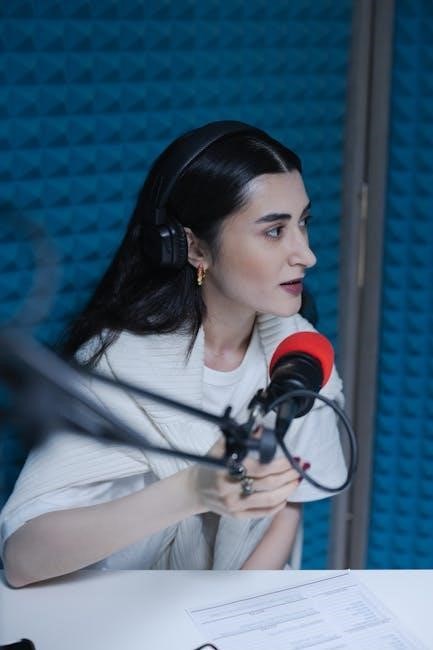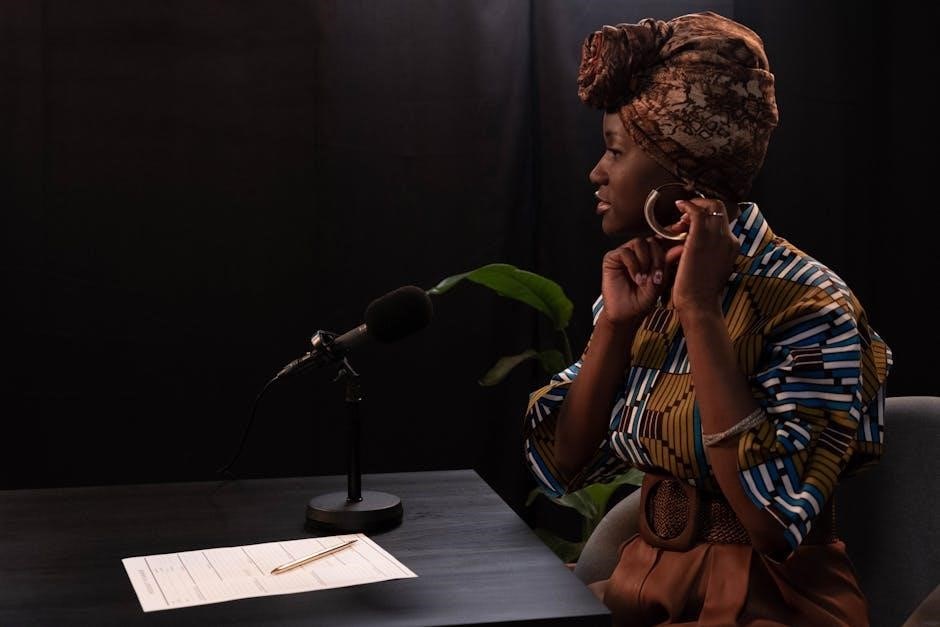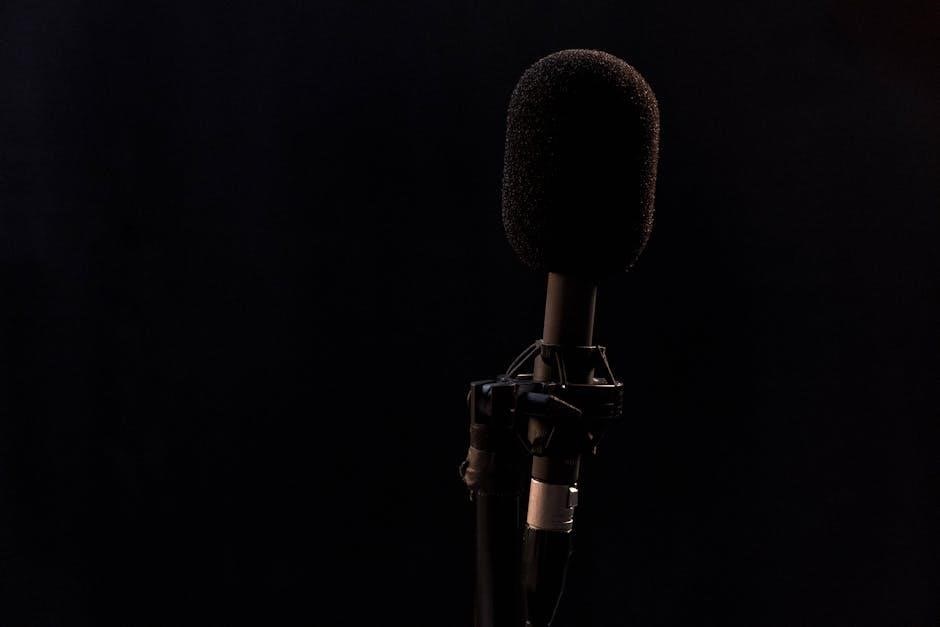The 1938 War of the Worlds radio broadcast, directed by Orson Welles, remains a landmark event in media history, sparking widespread panic through its innovative storytelling and realistic format.
Overview of the 1938 Radio Play
The 1938 War of the Worlds radio play, presented by Orson Welles and the Mercury Theatre on the Air, was a groundbreaking broadcast that aired on October 30, 1938. It was an adaptation of H.G. Wells’ 1898 novel, reimagined for radio with a modern twist, setting the story in contemporary New Jersey. The play employed a fake news bulletin format, creating a sense of realism that led many listeners to believe a real alien invasion was underway. This innovative storytelling technique, combined with its Halloween eve timing, caused widespread panic among the audience. The broadcast’s structure, which mimicked real-time news reports, added to the confusion, as it lacked clear disclaimers identifying it as fiction; The play’s impact was so significant that it remains one of the most infamous radio broadcasts in history, highlighting the power of media to shape public perception. Its legacy continues to be studied and celebrated as a pioneering moment in radio drama.
Historical Context of the Broadcast
The 1938 War of the Worlds radio broadcast occurred during a tense period in world history, with rising concerns over fascism in Europe and technological advancements in media. Radio was a primary source of entertainment and news, fostering a sense of immediacy and trust among listeners. The broadcast aired on Halloween eve, a time when audiences were more open to suspenseful and fantastical content. The Mercury Theatre on the Air, led by Orson Welles, capitalized on this atmosphere by presenting a fictional story as a series of breaking news reports, blurring the line between entertainment and reality. This approach, while innovative, also tapped into underlying anxieties about global instability and the unknown, contributing to the widespread panic it caused. The broadcast’s impact was magnified by its timing, highlighting the power of media to influence public sentiment during uncertain times. The historical context underscores how the program resonated with the fears and hopes of its era.
Significance of the Script in Media History
The script of the 1938 War of the Worlds radio broadcast holds a pivotal place in media history for its groundbreaking use of storytelling and format. By presenting a fictional narrative as a series of breaking news reports, the script blurred the line between entertainment and reality, creating a sense of immediacy and authenticity. This innovative approach not only caused widespread panic but also demonstrated the power of radio as a medium to shape public perception. The script’s use of real-time reporting techniques influenced future radio dramas and paved the way for immersive storytelling in other media forms. Its impact highlighted the importance of scriptwriting in shaping audience experiences, making it a landmark in the evolution of media and entertainment. The script’s legacy continues to inspire creators in radio, television, and digital media, showcasing its enduring relevance.

The Script and Its Development
The script, adapted by Howard Koch, transformed H.G. Wells’ novel into a radio drama, blending original material with the classic story to create a unique broadcast experience.
Adaptation from H.G. Wells’ Novel
The radio script of War of the Worlds was adapted from H.G. Wells’ 1898 novel, preserving the core narrative of a Martian invasion while modifying it for a radio audience. Howard Koch crafted the screenplay, maintaining the original story’s tension and suspense but presenting it in a contemporary American setting. The adaptation focused on creating a sense of immediacy, using news bulletins and eyewitness accounts to engage listeners. While the novel’s Victorian context was altered, the themes of human vulnerability and technological warfare remained central. This adaptation not only honored the source material but also reimagined it for a new medium, ensuring its relevance and impact in the 20th century.
Key Changes in the Radio Play Version

The 1938 radio adaptation of War of the Worlds introduced significant changes to H.G. Wells’ novel, transforming it into a contemporary American context. The story was shifted from Victorian England to New Jersey, making it relatable to U.S. listeners. The script omitted the novel’s philosophical musings, focusing instead on dramatic tension and suspense. The radio version also adopted a news bulletin format, presenting the narrative as real-time events, which heightened the sense of realism. This format included fake news reports, interviews, and emergency broadcasts, creating a documentary-like feel. These changes not only modernized the story but also amplified its impact, making the fictional invasion feel eerily plausible to the audience. The alterations were crucial in crafting the broadcast’s enduring legacy as a masterclass in storytelling and media innovation.
The Role of Howard Koch in Scriptwriting
Howard Koch played a pivotal role in adapting H.G. Wells’ War of the Worlds into the 1938 radio script. He streamlined the narrative, transforming the novel’s episodic structure into a cohesive, fast-paced drama. Koch’s script emphasized suspense and realism, incorporating news flashes and eyewitness accounts to create an immersive experience. His dialogue was sharp and direct, enhancing the tension as the Martian invasion unfolded. Koch’s work laid the foundation for the broadcast’s success, blending science fiction with journalistic style. His collaboration with Orson Welles ensured the script’s dramatic impact, making it one of the most memorable radio plays in history. Koch’s contributions remain essential to the legacy of this landmark production.

Production and Broadcast Details
Orson Welles directed the 1938 broadcast of War of the Worlds for Mercury Theatre on the Air. Aired on October 30, it captivated over 32 million listeners with its realistic format.
The Mercury Theatre on the Air
The Mercury Theatre on the Air was a radio anthology series produced by Orson Welles and John Houseman, known for its innovative adaptations of literary classics. The series began in 1938 and was renowned for its high-quality productions, often featuring elaborate sound effects and a talented ensemble cast. The program was designed to bring classic literature to a broad audience through the medium of radio, offering a unique blend of drama, suspense, and storytelling. Welles’ involvement as both director and actor elevated the series, making it a standout in the golden age of radio. The War of the Worlds broadcast was a pivotal episode in the series, showcasing its ability to engage and sometimes unsettle listeners with its gripping narratives. This approach not only entertained but also set new standards for radio drama.
Orson Welles’ Involvement and Direction
Orson Welles was the driving force behind the 1938 War of the Worlds radio broadcast, serving as both director and narrator. His innovative direction brought H.G. Wells’ novel to life, blending suspense and realism to captivate listeners. Welles’ decision to present the story as a series of news bulletins and eyewitness accounts was groundbreaking, creating a sense of immediacy and authenticity. His deep, commanding voice added gravity to the narration, while his pacing and tone heightened the drama. Welles also made key creative choices, such as setting the story in contemporary New Jersey rather than London, to make the events feel closer to the audience. His involvement not only shaped the broadcast’s success but also cemented his reputation as a visionary in radio and theater. Welles’ directorial brilliance transformed the production into a cultural phenomenon, leaving a lasting impact on media history. His work on War of the Worlds remains a testament to his artistic genius.
The Cast and Their Performances
The cast of the 1938 War of the Worlds radio broadcast delivered performances that were pivotal to its success. Orson Welles, as both narrator and director, set the tone with his authoritative voice, while other actors played roles ranging from scientists to radio announcers. Their portrayals were so convincing that many listeners believed the events unfolding were real. The actors’ ability to convey fear and urgency added to the broadcast’s realism, enhancing its dramatic impact. Despite the limited resources of radio theater, the cast’s talent and dedication brought the story to life, making the broadcast unforgettable. Their performances remain a key factor in the enduring legacy of this historic radio play. The cast’s collective effort helped create a sensation that would be remembered for generations.
Technical Aspects of the Broadcast
The 1938 War of the Worlds radio broadcast relied heavily on innovative technical elements to create its immersive experience. Sound effects played a crucial role, simulating Martian machines, explosions, and crowd chaos using everyday objects like dishes and water. The music, composed by Bernard Herrmann, heightened tension with a dramatic score. The broadcast’s format, presented as a series of news bulletins, added realism, while the lack of commercial interruptions maintained the illusion of a real-time event. The technical team skillfully transitioned between scenes, blending dialogue, sound effects, and music seamlessly. These technical aspects, combined with the cast’s performances, created a gripping narrative that captivated listeners. The effective use of radio’s limitations turned the broadcast into a landmark of audio storytelling, proving that simplicity could evoke powerful imagery and emotion.

The Broadcast Itself
Aired on Halloween night, October 30, 1938, the War of the Worlds broadcast captivated listeners with its realistic news bulletin format, creating widespread panic and hysteria among its audience.


Structure of the Radio Play
The 1938 War of the Worlds radio play was structured as a series of simulated news bulletins, creating a sense of real-time events unfolding. The narrative began with a weather report, followed by a statement about strange explosions on Mars. As the story progressed, reports of a Martian cylinder landing in New Jersey transitioned into dramatic descriptions of alien attacks, military responses, and societal collapse. The play’s format mimicked a typical radio broadcast, with interruptions for “breaking news” and eyewitness accounts, which heightened its realism. The script’s structure, blending factual reporting with science fiction, contributed to the widespread panic, as listeners believed they were hearing actual events unfold. This innovative storytelling approach emphasized immediacy and urgency, making the fictional invasion feel eerily plausible to its audience. The play’s climax featured the narrator fleeing the chaos, further immersing listeners in the unfolding drama.
The Use of News Bulletin Format
The 1938 War of the Worlds radio broadcast employed a news bulletin format to create a sense of authenticity and immediacy. By mimicking real-time news reports, the play’s script simulated breaking updates about a Martian invasion, complete with interviews, eyewitness accounts, and government statements. This format allowed the story to unfold as if it were actual events, with interruptions and urgent announcements that heightened the drama. The use of a familiar news structure made the fictional narrative feel plausible, leading many listeners to believe the events were real. This approach not only showcased the power of radio as a medium but also demonstrated how storytelling could blur the line between fiction and reality, leaving a lasting impact on media history and public perception. The innovative use of the news bulletin format remains a key element in the broadcast’s enduring legacy.
Sound Effects and Music in the Broadcast
The 1938 War of the Worlds radio broadcast relied heavily on sound effects and music to enhance its dramatic impact. The production team created realistic audio cues, such as simulated radio static, explosions, and eerie, otherworldly sounds, to immerse listeners in the narrative. Bernard Herrmann’s original score added tension and suspense, while sound effects like the Martian heat ray and tripod movements were crafted to evoke fear and chaos. The use of a live studio orchestra and innovative audio techniques brought the story to life, making the fictional invasion feel alarmingly real. These elements, combined with the news bulletin format, were crucial in creating the broadcast’s infamous panic. The interplay of sound and silence remains a testament to the power of radio storytelling, demonstrating how audio could shape perception and emotion in a pre-visual media era.

Public Reaction and Aftermath
The broadcast sparked mass hysteria, with listeners believing the Martian invasion was real. Widespread panic led to media scrutiny, highlighting the power of radio and its potential for misinformation.
The Panic and Hysteria Caused by the Broadcast
The 1938 War of the Worlds broadcast caused widespread panic, with listeners believing a real Martian invasion was underway. The show’s news bulletin format created a sense of urgency and authenticity, leading many to fear for their lives. Reports of people fleeing their homes, churches filled with prayer, and frantic calls to newspapers and police stations emerged. The media amplified the hysteria, with headlines the next day highlighting the chaos. Despite disclaimers, the broadcast’s gripping narrative and realistic sound effects convinced audiences of its truth. This event remains a stark example of radio’s power to shape public perception and the blurred lines between fiction and reality. It also sparked debates about media responsibility and the potential for mass misinformation. The hysteria surrounding the broadcast solidified its place in history as a cultural phenomenon.
Listener Response and Misinterpretation
Listeners’ reactions to the 1938 War of the Worlds broadcast were shaped by the program’s innovative format, which mimicked real-time news reports. Many tuned in late, missing the opening disclaimer that the story was fictional. This led to widespread misinterpretation, as audiences believed the Martian invasion was real. The show’s use of breaking news bulletins, interviews, and emergency alerts heightened the illusion. Panic ensued, with some listeners fleeing their homes or seeking shelter. The broadcast’s effectiveness lay in its ability to blur the line between fiction and reality, creating a unique psychological impact. This misinterpretation underscored the power of radio as a medium and highlighted the importance of clear communication in broadcasting. The incident also sparked discussions about media literacy and the potential for mass misinformation. The enduring legacy of this broadcast lies in its ability to captivate and unsettle audiences, even decades later.
Media and Public Backlash
The 1938 War of the Worlds broadcast sparked intense media and public backlash. Newspapers across the U.S. sensationalized the panic, with headlines exaggerating the scale of hysteria. Critics accused Orson Welles and the Mercury Theatre of irresponsibility, claiming the show misled listeners. Public opinion was divided, with some calling for stricter regulations on radio content, while others praised the broadcast as a bold experiment in storytelling. The controversy led to a national debate about the power of media and its potential to manipulate public perception. Despite the backlash, the broadcast solidified Welles’ reputation as a groundbreaking artist. The incident also prompted radio networks to adopt clearer disclaimers for fictional programming, ensuring audiences could distinguish fact from fiction. The backlash highlighted the delicate balance between artistic innovation and public trust in media.

Legacy and Impact
The 1938 War of the Worlds radio broadcast became a landmark in media history, influencing science fiction and modern adaptations, while remaining a timeless example of radio’s power.
The Broadcast’s Place in Radio History

The 1938 War of the Worlds radio broadcast holds a significant place in radio history as one of the most influential and controversial programs ever aired. Directed by Orson Welles and performed by the Mercury Theatre on the Air, it showcased the medium’s power to engage and unsettle audiences through its innovative use of news bulletin format and realistic sound effects. The broadcast not only demonstrated radio’s ability to evoke strong emotional responses but also highlighted its potential for storytelling and immersion. Its legacy endures as a landmark moment in media history, illustrating how radio could shape public perception and spark widespread discussion. The program’s impact on science fiction and its continued relevance in contemporary media underscore its enduring influence on broadcasting and popular culture.
Influence on Science Fiction and Media
The 1938 War of the Worlds radio broadcast profoundly influenced science fiction and media, setting a precedent for immersive storytelling and blending fact with fiction. Its innovative use of the news bulletin format created a sense of realism, inspiring future adaptations in film, television, and stage productions. The broadcast’s ability to evoke mass hysteria highlighted the power of media to shape public perception, a theme that resonates in contemporary discussions about misinformation and fake news. Orson Welles’ direction and Howard Koch’s script elevated the story’s tension, making it a benchmark for science fiction narratives. The broadcast’s legacy continues to inspire creators, ensuring its relevance in exploring humanity’s response to the unknown and its resilience in the face of catastrophic events. Its impact on popular culture remains undeniable, cementing its place as a groundbreaking moment in media history.
Modern Adaptations and Tributes
The 1938 War of the Worlds radio broadcast has inspired countless modern adaptations, including films, stage plays, and even updated radio dramas. A 2011 remastered version of the original broadcast was released, preserving its historical significance while introducing it to new audiences. Screenwriters like Josh Friedman and David Koepp have crafted contemporary interpretations, blending the original story with fresh perspectives. The script’s innovative format, blending news bulletins with dramatic narration, has influenced modern storytelling in media. Tributes to the broadcast can be seen in TV shows and films that explore similar themes of mass hysteria and the power of media. Its enduring relevance is evident in academic discussions, such as a 2021 paper highlighting its parallels to modern concerns about misinformation. The broadcast’s legacy continues to inspire creators, ensuring its influence remains vibrant in contemporary culture.
The War of the Worlds radio broadcast remains a pivotal moment in media history, blending storytelling with realism to captivate audiences and inspire future adaptations and reflections on its legacy.
Final Thoughts on the War of the Worlds Broadcast
The 1938 War of the Worlds broadcast, directed by Orson Welles, is a seminal moment in radio history, blending drama with journalistic style to create mass hysteria; Its script, adapted by Howard Koch from H.G. Wells’ novel, used news bulletins to simulate real events, causing widespread panic among listeners. This innovative approach not only showcased the power of radio as a medium but also highlighted the potential for media to shape public perception. The broadcast’s legacy endures, influencing science fiction and media, while its exploration of themes like fear and misinformation remains relevant today. It stands as a testament to the enduring impact of storytelling and the importance of critical media literacy.
Its Enduring Relevance in Contemporary Media
The 1938 War of the Worlds broadcast remains a powerful example of media’s ability to shape perception and evoke emotion. Its use of a fake news format sparked hysteria, mirroring modern concerns about misinformation and fake news. The script’s innovative blend of drama and realism has influenced countless adaptations, from films to stage productions, ensuring its relevance in popular culture. Today, the broadcast serves as a cautionary tale about the impact of media on society, highlighting the importance of critical thinking. Its exploration of fear, chaos, and human reaction continues to resonate, making it a timeless study in the psychology of media consumption. The broadcast’s legacy underscores the enduring power of storytelling to captivate and unsettle audiences, even in the digital age.

